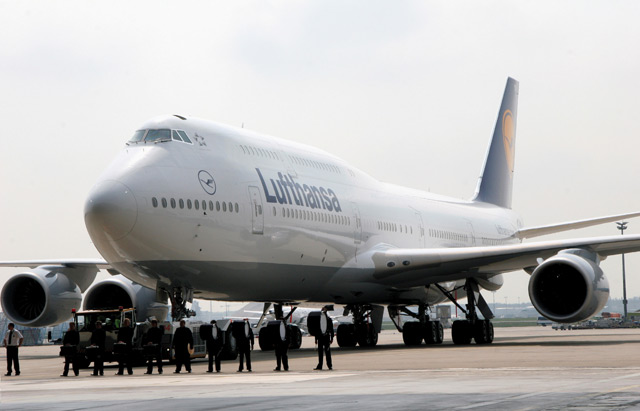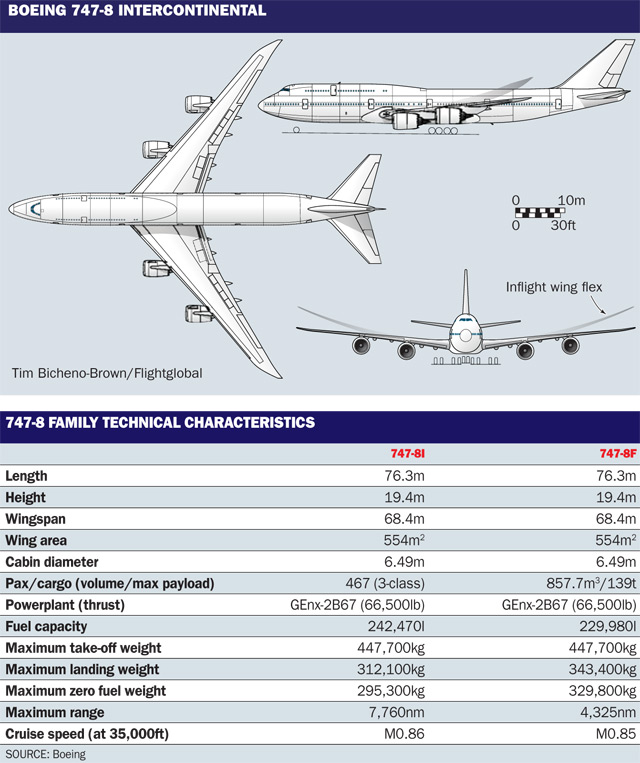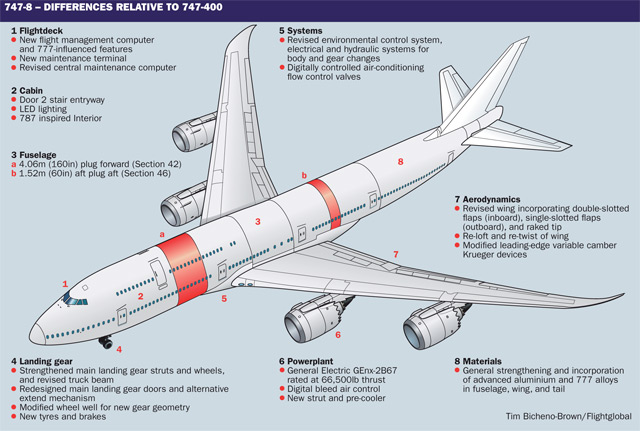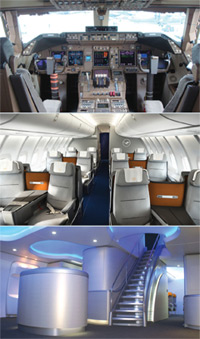More than four decades after Pan Am debuted the Boeing 747-100, a stretched variant of the world's original Jumbo Jet is finally plying the world's air routes. But by the time this bigger "seven-forty-seven" arrived, Airbus had already redefined the meaning of "Jumbo Jet" with its A380. So the battle for that "queen of the skies" crown was on.
Boeing had spent a decade evaluating ways to create a substantially larger 747, before decide in November 2005 not to let Airbus off the hook too easily. Scoped under the name "747 Advanced", the stretch was launched as the "747-8" to reflect the naming convention around the number eight adopted for the 787 then in development. Along with the Dreamliner's designation came its General Electric GEnx engines - although featuring a conventional bleed system for air-conditioning.
 |
|---|
Max Kingsley-Jones/Flightglobal Lufthansa banged the drum for its new Jumbo when its first 747-8 arrived in May |
The 747-8 was originally slated for service entry in 2009, but a series of programme delays, caused by development issues and a knock-on from the interruptions suffered by the 787 programme, meant the first stretched aircraft did not leave the ground until February 2010. The new jet finally entered service - in freighter form - with Cargolux in October last year. The 747-8 Intercontinental passenger variant followed in June this year, debuting with Lufthansa.
The "big Boeing" is in effect a major derivative of the 747-400 that had been launched two decades earlier, which itself traces its DNA right back to the original Jumbo developed in the late 1960s by a team headed by industry legend Joe Sutter.
Now aged 91, Sutter has been officially retired from Boeing for more than 25 years, but retains an office at the company's Seattle headquarters so he can keep a watchful eye on the latest iteration of his precious creation.
"Joe's still as sharp as ever and we talk about the airplane a lot," says today's 747 chief project engineer Bruce Dickinson. "I welcome Joe's opinions and input."
Unlike some of the more ambitious studies of the 1990s, the definitive 747 stretch does not incorporate a major fuselage extension and enlarged wing. Instead, the fuselage has been treated with a modest stretch, with plugs fore and aft of an effectively all-new - but similarly sized - wing.
TYPE COMMONALITY
"About 70% by structural weight is new. In many respects, though, we could state almost all of the airplane is new, as we have heavier gauge materials that have similar construction as the 747-400," says Dickinson. "We strove for a lot of commonality in general, though, as it is a huge advantage to us for our installed fleet. You see that with a lot of our systems, where we've tried to keep it common."
Both freighter and passenger variants feature the same-sized plugs fore and aft, although this was not always the case. While both have 1.52m (60in) aft plugs, the 747-8I model initially had a shorter 2.03m forward plug. A year after its launch, Boeing adopted the -8F's 4.06m forward plug dimensions for the -8I, to further boost capacity.

This means that the stretch increases the overall length of both models to 76.3m. On the passenger variant, this raises nominal three-class seating capacity over the 747-400 by 51 seats to 467, while on the freighter, it allows for two additional pairs of 96x125in pallets on the main deck and three more pallets on the lower deck. Overall, the 747-8F has 16% more capacity than the 747-400F.
The decision to stretch the 747-8I further - which increased passenger capacity by 17 seats, but reduced range by about 270nm (500km) - did not have unanimous appeal. Emirates was evaluating the 747-8I at the time, having already ordered the 747-8F for its cargo arm, and wanted Boeing to concentrate on the range rather than capacity.
"We have made it clear to Boeing that we prefer the [original] stretch because of its greater range at maximum payload," said the airline's president Tim Clark.
"With Tim's Middle East to US West Coast type [range] hunger, that's the classic tension of trying to hit his sweet spot of the market," says Dickinson.
Boeing's decision to go with the larger -8I was vindicated shortly after, when Lufthansa became launch customer for the revised passenger version, with a deal for 20 747-8Is in November 2006.
HEAVY WEIGHT
The forward plugs in the 747-8I and -8F are inserted in slightly different positions within the fuselage (see below). The passenger model's plug is between doors one and two to extend both the main and upper decks, while the freighter's is inserted further aft, closer to the front of the wing box, which avoids what would be a pointless increase in the length of the unused upper deck.
ALL-CHANGE ON THE INSIDE There is a stark contrast between the experience passengers have when stepping into the new Boeing 747 family, and that of the flightcrew. While the cabin has undergone a significant, 787-inspired makeover, the flightdeck will feel very familiar to 747-400 pilots.
An important change is the elegant sweeping staircase, which leads to the enlarged upper deck. Located adjacent to door two, it is also designed to improve passenger flows between the two decks during turnaround. This change is significant as the stretch creates an upper-deck cabin that is similar in size to the main cabin of a 737-300/700. In a typical three-class layout, Boeing says that 48 business class seats can be accommodated on the 747-8I's upper deck, compared with 40 on the -400. Adding to the ambience is a revised passenger window design. The 747-8I's cabin windows are 388mm (15.3in) tall and 273mm wide, giving an estimated 8% increase in the usable viewing area. "We transitioned to a more oval-shape window and reveal, which is modelled after that of the 777," says 747 chief product engineer Bruce Dickinson. AT HOME Pilots of the 747-400 will feel right at home in the -8's flightdeck, which is equipped with a Rockwell Collins avionics and display suite. There are some revisions such as a new Honeywell flight management computer and 777-style electronic checklist, cursor control panel, multi-function displays and air traffic control datalink. It also has a new maintenance terminal and a revised central maintenance computer. An interesting development for the 747 VIP market is the Aeroloft, designed by Greenpoint Technologies specifically for the 747-8, which has been chosen by some customers. The Aeroloft offers eight private sleeping berths and a changing room and is located above the main cabin aft of the upper deck. |
The aircraft's maximum take-off weight was increased by around 6t during testing after a flight loads survey revealed that additional structural margin was available. Boeing said the MTOW increase was not aimed specifically at restoring payload/range capability lost as a result of the growth in structural weight during development.
Boeing focused on weight reduction during the design phase through the use of new materials. There is extensive use of carbonfibre in secondary structures, while the fuselage incorporates new advanced aluminium alloys throughout its length (other than the passenger doors), as does the wing. A weight-saving effort is expected to bring later aircraft close to the original empty-weight target.
Aside from the stretch, there is little visual difference between the -8 fuselage and earlier marks. But the same is not true for the wing.
"The wing is key to this airplane, combined with the GEnx engines, and what makes it so dramatically different from its predecessors," says Dickinson. "There's the advanced technology airfoil with the supercritical wing and raked wingtip designed using computational fluid dynamics, giving it the same technology level as the 787 wing. It is extremely efficient."
The wing shares little with the 747-400 other than its 35˚ sweep and incorporates new materials that help reduce weight. The design features an optimised reloft and retwist, while the raked tip (in place of the winglet on the -400) increases wing span by 4m to 68.4m. "The new wing has similar dimensions to the earlier wing, but it is quite different. We really did not use any of the earlier aerodynamic features," says Dickinson. Although he declines to reveal the area of the new wing for competitive reasons, Lufthansa quotes a figure of 554m².
The wing incorporates revised leading and trailing edge high-lift devices while fly-by-wire outboard ailerons "enable the wing to be even more efficient with the weight reduction, by providing manoeuvre load alleviation, which is new for the 747. This gives us a significant advantage for weight."
The ailerons are optimised to span-load in cruise flight and Boeing has introduced a droop capability as a performance improvement. "We developed this initially on the Intercontinental and have since introduced it on the Freighter," says Dickinson.
"We realised during -8I flight-testing that we had the opportunity to better position the aileron to optimise span-loading and discovered a 0.4% improvement, which is a pretty significant number."
WING CHANGES
The wing's major changes centre on the flaps. "Optimising the trailing edge is a real opportunity for performance," says Dickinson.
All earlier marks (except the 747SP "shrink") incorporate triple-slotted trailing-edge flaps, but the -8 has adopted a double-slotted inboard and single-slotted outboard design, which extend on redesigned tracks and new carriages. The leading-edge variable camber Krueger flaps have also been redesigned to incorporate a gapped configuration. Actuation systems are unchanged. The spoilers are also now fly-by-wire.

Boeing spent a lot of time during flight-testing optimising the flap settings to improve on the approach speeds, which is "always a challenge, but we did this successfully". Dickinson says that "fundamentally, the wing's structural design is not entirely different" from earlier variants, although advanced aluminium alloys are incorporated in the wing and carbon composites are used for the trailing edge and raked tip.
During development, the changes to the 747 airfoil design created a variety of new problems. Speaking at the time, the programme's then chief engineer Michael Teal explained: "When we changed the wing airfoil and ultimately changed the centre of gravity, it fundamentally shifted how the whole aircraft balances loads. As the loads shifted back on the wing, the tail is the balancing load. So we changed more parts in the tail. Then the loads in the aft body changed, so we had to change the aft body."
The knock-on effect was that the 747-8 supply chain was thrust into limbo as it waited to adjust tooling and this contributed to the two-year programme delay.
"After we put that issue behind us, no follow-up was required since I joined the programme," says Dickinson.
The wing side-of-body has the same basic overall geometry and construct to the -400, but "has been 'gauged up' to account for the increased loads on the 747-8", Dickinson says. "The fairings are unchanged in basic geometry. However some changes to material, gauge and local geometry were required due to increased loads, systems changes, increased tyre size and environmental control system [ECS] pack temperature differences."
Dickinson says that there are no significant differences in the primary structure of the tail section. "The materials have been updated and gauges changed slightly. But we did adopt a double-hinged lower rudder."
NASA TECHNOLOGY
Power comes from four GEnx-2B67 engines rated at 66,500lb-thrust (296kN), which although derived from the 787's GEnx-1B, are optimised for the 747-8. The engines share the same core and 80% of the line replaceable units. The GEnx-2B incorporates a 2.67m fan, digital bleed control and a new pre-cooler. The four engines are suspended from a new pylon design and wrapped in nacelles that make extensive use of carbonfibre.
 |
|---|
The 787-style noise-reducing "saw-tooth" chevrons are incorporated into both the trailing edge of the fan cowls and inner core engine nozzles. These NASA-developed devices smooth the hot air as it flows from the engine core and mixes with cooler air from the fan, reducing the noise-creating turbulence.
The 747-8I has a 30% smaller noise footprint than its predecessor, being approved for quota count 2 (QC2) take-offs and QC1 arrivals at the London airports.
GE says that the GEnx-2B is designed to have 13% better fuel efficiency over the CF6 engine, which powers the 747-400. However, the performance fell short of the original target and GE is working on a performance improvement package (PIP) to close the gap (see below).
Revisions and updates were made to the 747 systems on the new family. "We're heating and cooling slightly larger volumes and we've used different suppliers," says Dickinson.
The aircraft features a revised ECS and changes to the electrical and hydraulic systems. Liebherr Group's Liebherr-Aerospace Toulouse division supplies the ECS, which takes its air from the GEnx-2Bs.
The system uses new technologies to improve performance. These include an integrated air system controller and high-pressure water separation which dry the air within the air cycle machine upstream of the turbine section input. The ECS also incorporates an advanced bleed system and subfreezing packs.
With an MTOW 13% greater than the -400's, the 747-8 is equipped with a strengthened and revised landing gear supplied by Goodrich. The main landing gear (MLG) struts and wheels have been strengthened and the truck beam length revised. The wheel well has been adapted for the new gear geometry, while the MLG has modified doors and incorporates an alternative extend mechanism. The 18 wheels feature new tyres and brakes.
Modification was made to the shape of the wing MLG doors after a buffet issue was discovered following flight-testing. "Testing always uncovers a lot of interesting things," says Dickinson.
DOOR REDESIGN
The original door was derived from the -400's, but the changes to the wing and trailing edge created "a body/wing interface that we didn't fully appreciate. Once the source of the aerodynamic issue was discovered, we were able to work our way through that", he says.
The change centred on the size and position of the lower part of the door, which is now at a reduced angle to the vertical.
The door-buffet issue was resolved during flight-testing before the first 747-8I joined the flight-test programme on 20 March 2011. The passenger variant was awarded US Federal Aviation Administration certification on 14 December 2011 and the first delivery - to an undisclosed VIP customer - took place on 28 February. This marked the first delivery of a passenger 747 for seven years.
The 747-8F has been the lead variant in both development and sales, with total orders standing at 70 from eight customers. Since the landmark Lufthansa deal in 2006, sales of the 747-8I to airlines have been sluggish, with just three more customers added to date: Air China (five), Arik Air (two) and Korean Air (five). A further nine 747-8Is have been ordered by undisclosed customers for the VIP role (of which four have been delivered). Russian carrier Transaero signed a preliminary agreement for four 747-8Is last year but has yet to firm up the deal.
Lufthansa debuted the new Jumbo on 1 June between Frankfurt and Washington DC after taking delivery of what was the 1,443rd 747 off the line on 25 April. And guess who was keeping a watchful eye on proceedings at the handover in Everett? The 747-8's very proud grandfather... Joe Sutter.
BOEING AND GE FOCUS ON PERFORMANCE BOOST
Boeing advertises the 747-8 as having 10% lower seat-mile costs than the 747-400 and 2% lower trip costs. But maximising the new Jumbo's efficiency has become a slog after early-build aircraft came in overweight and the General Electric GEnx-2B missed its original fuel-burn target by 2.7%.
Boeing, in conjunction with GE, is working on a package of engine, aerodynamic and weight improvements to address all the issues and ensure that the performance of 747-8s delivered from 2014 will be "within 1%" of the original target, says chief project engineer Bruce Dickinson.
TARGETS SET
"For the current as-delivered airplanes, we are consistently seeing a real-world fuel burn that is 1% better than our forecast. So with the increment for the PIP [performance improvement package] engine - which is audited to be a 1.6% improvement above today - it puts us right on track to meet our as-promised performance," he says.
Dickinson says GE is "bullish" that it can beat the 1.6% targeted for the PIP. Testing for the package will begin in mid-2013 and approval is scheduled for the end of next year.
One improvement that will be incorporated in the PIP for the freighter is a higher-thrust rating for use at hot and high airports. "This gives up to 4% additional thrust and will provide great capability for a number of city pairs such as Mexico City-Bogata or from airports in China," says Dickinson.
 |
|---|
Max Kingsley-Jones/Flightglobal All-new: GEnx-2B engines and redesigned wing deliver big performance gains |
In parallel with GE's PIP, Boeing has a weight-saving programme targeting a 2,270kg (5,000lb) reduction and is working on aerodynamic improvements. One aspect of the latter is the aileron droop, which has already been introduced on the 747-8I.
Other efficiencies being developed include improved nacelle leakage and rigging improvements around the aft end - primarily the rudder - to reduce cruise drag. There are other "study items" under evaluation, says Dickinson.
"We're always looking for minor improvements - a 10th here and a 10th there - as the production line becomes more consistent and stable. Virtually all the improvements can be retrofitted, although some could be a little time-consuming to do."
One item at the top of Dickinson's to-do list is the re-activation of the -8I's 12,500 litre (3,300 USgal) tailplane fuel tank. An analytical model showed that in certain scenarios, a flutter condition could occur when fuel is in the tank, so the decision was taken to disable the tank prior to certification.
"We're on track to work our way through that and get it certified and activated with some relatively minor changes," says Dickinson.
The other main focus of improvements is around the flight management computer, for which a series of upgrades is being introduced.
"We rolled in the 'FMC 2.5' load around August, which addresses some nuisance warnings but the real motivation was to activate the FMC V speeds," says Dickinson. "'FMC 2.6' will be introduced at the end of the year to provide a tweak to those V speeds - and is something that will be able to be applied to the 747-400."
A major update, dubbed "FMC 3.0", is scheduled for the end of 2013 and will "complete all the different nuances that the customers have asked for".
The upgrade will incorporate a host of new capabilities such as required navigation performance, a quiet climb function and "other bells and whistles features that will help the airplane operate slightly more efficiently and bring some other features into the airplane", Dickinson says.
Boeing will undertake a major flight-test programme in mid-2013 to clear the GEnx PIP, FMC 3.0 update and the modifications needed to reactivate the tail fuel tank. Approval of all these is due at the end of next year.
Source: Flight International




















